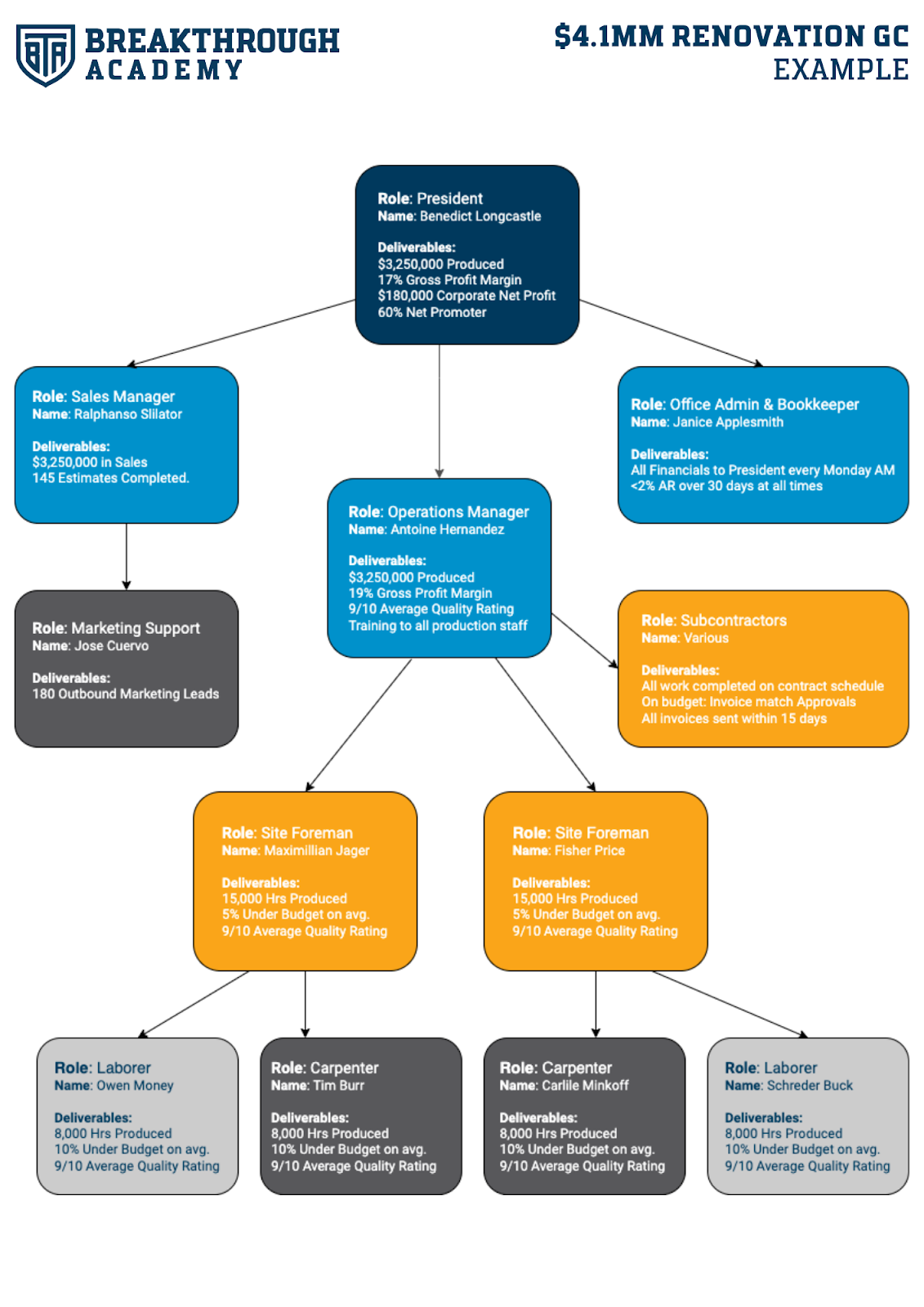

How to Create a Construction Company Org Chart

Scaling Up? You Need a Clear Construction Company Org Chart
To grow from $1M to $10M (or more!), a well-defined builder org structure is key to making it happen.
After years of sweat and toil, you’ve finally been able to hire more people – big pat on the back!
But instead of it taking work off your plate, it’s somehow left you busier than ever. You’re bombarded with questions, important actions are getting missed and your staff are constantly tripping over each other.
You’ve added roles, but somehow… you’ve also added confusion.
For builders, growth can be a double-edged sword when it comes to expanding the team, which is why having a well-structured org chart is vital. It brings improved communication, enhanced efficiency and – most excitingly – smooth scalability.
Here’s what you need to know to get your team moving like a well-oiled machine, and find the calm you deserve.
What is a builder org chart?
An organizational chart (we’ll go with “org chart” ‘cause who has time for that many syllables?) outlines the structure of the roles within your company. Essentially, it provides an at-a-glance picture of who does what.
But it’s much more than just a bunch of boxes and titles. A carefully constructed org chart should also capture:
- Deliverables
- Responsibilities
- Accountabilities
You can think of it like a foundation for operational clarity. Once you’ve got a solid org chart, you can build efficient processes on top of it.
Buildertrend can help you accomplish that as an operations platform that integrates seamlessly with your team structure. For example, if your org chart includes a dedicated Project Manager, the tasks in their workflow can be easily tracked and completed, including:
- Assigning tasks
- Managing schedules
- Updating job progress
All this being said, even the most robust operational tool is only as effective as the org structure it’s based on.
How to build an org chart
While it can be tempting to scribble a bunch of squares on a page and call it a day, that’s unlikely to bring productive results.
Here’s a brief overview of how to put together an org chart that ensures your business operates effectively for many years to come.
Create distinct roles
Each role in your org chart must be clearly defined. As you start to ring fence each role, be mindful about the following missteps.
- Unicorn roles – These consist of an impossible combination of skillsets. Like an admin guru who can run your marketing campaigns while also leading projects.
- Dual roles – These scenarios involve people in overlapping roles. For instance, a project manager doubling as a sales manager. While this can be an unavoidable situation for growing builders, it’s something you’ll want to rectify eventually. Be sure to mark the roles as separate squares on the org chart so you know you’ll have to make a hire down the road.
Even if you manage to wedge someone into one of these positions, they’re unlikely to succeed, which means you’ll be back to drawing boxes again.
Consider who you’ll need in the next 12 months
Don’t just build the chart you need today, design the company you envision for the future. It’s not to say you need to fill every role right now, but planning well ahead has a lot of benefits:
- You’ll be able to hire more thoughtfully, taking your time to find the best candidate.
- You can be more proactive about how you run your business.
- You’ll avoid delays from suddenly needing more hires halfway through a job.
Obviously, nobody knows exactly what the future holds, but a good plan goes a long way, and an org chart is a type of plan. Dare we say, even a sort of destiny…
Anchor each role in deliverables
When you’ve set definitive goals for your construction business, you can assign metrics as deliverables associated with each role in your org chart.
These are tangible numbers that are owned by that role. They will likely involve profitability, but they should extend beyond that as well. For example, quality of service is a major, and trackable, component of your success.
The deliverables in your org chart can include metrics such as:
- A sales manager needs to complete a certain number of estimates to convert enough lead into jobs.
- A project manager needs to ensure jobs stay within a certain gross profit margin.
- A general manager needs to ensure customer ratings stay above a certain limit.
As you define these points for each position, you also infuse purpose into the role, which is incredibly motivating for A-players (and those are the ones you want, right?).
Establish a clear reporting structure
Okay, so you’ve got your boxes with titles AND deliverables. Now what?
Now come the arrows! Even though you know who you need, you can’t stop there because you can’t have everyone reporting to you. (You’re trying to DECREASE your stress, remember?).
You’ve got to arrange those boxes into a hierarchy.
Ideally, you should have a few key roles reporting directly to you, such as a sales manager, an operations manager and an office manager. But each of those roles should have a team supporting them, otherwise there’s a risk they’ll burn out.
Each member of those teams should then also have their own set of deliverables, based on those of the team lead. Ultimately, all deliverables roll up to fulfill your overall business goals.
Dig deeper into the benefits and process of creating a builder org chart with this video from Breakthrough Academy.
Example of a construction org chart
How many boxes should your org chart have?
The exact right number for your construction business. Any more is wasteful, any less is ineffective.
The below template provides an example for a $4M renovator.

Once you’ve created your org chart, Buildertrend can help bring it to life, with functions to support the tasks of every operational role. For example:
- Your sales team can track leads and land jobs with the CRM and pre-sale features.
- Your project managers can keep tabs on progress with schedules, to-dos, and job logs.
- Your finance and admin staff can manage purchase orders, invoices and budgets.
- Your crew can complete daily logs and upload progress photos.
To guide you through the process of creating your org chart, Breakthrough Academy provides exceptional coaching for construction contractors, helping you systemize for success.
With a powerful tool and a dynamic support team, there’s no limit to what you can accomplish.
Start building a more efficient business today with this FREE Org Structure Resource Bundle.

Table of Contents










